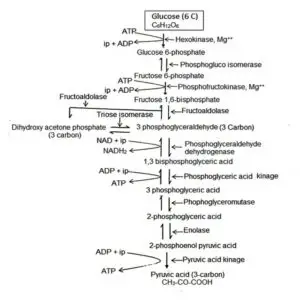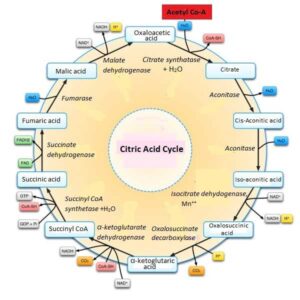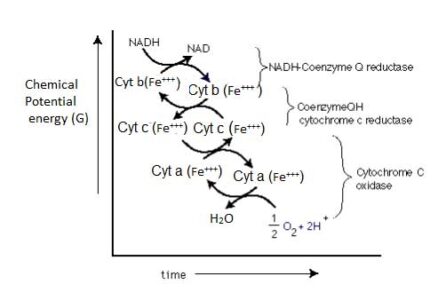Aerobic respiration is the process by which complete oxidation of respiratory substrate occurs. In this case, respiratory substrate glucose breaks down in the presence of oxygen resulting in the end products of CO2 and H2O. Most of the cells perform the respiration through aerobic process.

Aerobic respiration occurs by completing the series of chemical reactions. It includes the following four stages:
- Glycolysis
- Acetyl Co A Formation
- The Citric acid cycle
- The electron transport system
Glycolysis
Glycolysis is the metabolic pathway where one molecule of glucose(C6H12O6) converts into pyruvic acid by the help of enzyme. Glycolysis occurs in the cytoplasm of the cell during both anaerobic and aerobic respiration. It is also known as EMP pathway i.e., Embden-Meyerhof-Parnas pathway named after German Biochemists Gustav Embden, Otto Meyerhof, and Jakub Karol Parnas who first discovered the process of glycolysis in 1918. Glycolysis is also called Entner–Doudoroff pathway.
Features of Glyclysis
- Glycolysis happens in the cytoplasm;
- Glycolysis does not need or consume oxygen;
- A 6-carbon glucose is converted into 3-carbon pyruvate or pyruvic acid;
- In this case, 2 molecules of ATP are consumed to initiate the process.
- Four molecules of ATP and 2 molecules of NADH are produced after the end of the process.
Step of Glycolysis
Reaction of glycolysis include the following three steps:
- Phosphorylation of glucose or Preparatory Phase
- Cleavage of Fructose-1, 6-diphosphate
- Formation of 3-carbon pyruvate or pyruvic acid
Phosphorylation of glucose or Preparatory Phase
1. At the first step, glucose undergoes phosphorylation by ATP(Adenosine triphosphate) in presence of Mg++ to form glucose-6-phosphate in the presence of hexokinase enzyme.

2. By the process of isomerization Glucose 6-phosphate is isomerized into fructose 6-phosphate with the help of phosphogluco isomerase enzyme.

3. Fructose 6-phosphate undergoes phosphorylation with the help of ATP and enzyme phosphofructokinase to form Fructose 1, 6-bisphosphate and ADP (Adenosine diphosphate).

Cleavage of Fructose-1, 6-bisphosphate
4. Fructose 1,6-diphosphate is broken down to two triose (3 carbon molecule) phosphate such as dihydroxyacetone phosphate and 3 phosphoglyceraldehyde with the help of the enzyme aldolase. The dihydroxyacetone phosphate is converted to 3 phosphoglyceraldehyde with the help of enzyme triose phosphate isomerase. In this case, reaction is reversible. Here two molecules of 3-phosphoglyceraldehyde are formed from the cleavage of one fructose 1, 6-biphosphate.

Formation of 3-carbon pyruvate or pyruvic acid
5. With the help of NAD (nicotinamide adenine dinucleotide), H3PO4(phosphoric acid) and the enzyme phosphoglyceraldehyde dehydrogenase, 3 phosphoglyceraldehyde is oxidized to 1, 3-diphosphoglyceric acid and NADH2.

6. In this step 1, 3 diphosphoglyceric acid transfers phosphoric acid to ADP with the formation of 3 phosphoglyceric acid and ATP with the help of enzyme phosphoglyceric acid kinase.

7. In the next step 3 phosphoglyceric acid is converted to 2 phosphoglyceric acid with the help of enzyme phosphoglyceromutase.

8. 2 phosphoglyceric acid is then converted to form 2 phosphoenol pyruvic acid with the help of enzyme enolase which gives out one molecule of water.


Steps of Glycolysis
9. It is the last step of glycolysis where 2 phosphoenol pyruvic acid is converted to form pyruvic acid by the removal of phosphorus thus one molecule of ATP is synthesized from ADP. The enzyme catalyzing this step is pyruvic acid kinase.

So in the overall process, two molecules of pyruvic acid is formed from each molecule of glucose. In animals including human being glycogen is present in the muscle and liver cells, are phosphorylated by the glycogen phosphorylase enzyme in presence of inorganic phosphate into glucose 1 phosphate. Similarly starch of plant cells is converted to glucose 1-phosphate by the starch phosphorylase. Glucose 1-phospahte is then converted to glucose 6-phosphate by the enzyme phosphoglucomutase. Glucose 6-phosphate is then oxidized through the glycolytic path.
Reaction:

Thus when one molecule of glucose (6C) undergoes the reactions in glycolysis, the overall process may be represented as follows:

In this case, 2 molecules of ATP are used up in the phase of glycolysis.
Therefore the net gains of glycolysis are:

Significance of Glycolysis
- This process leads to the formation of 2 molecules of pyruvic acid which is essential for running the Krebs cycle.
- During the course of formation of 2 molecules of pyruvic acid from a hexose 4 ATP molecules are produced as a result of substrate phosphorylation per molecule of hexose utilized. Now 2 ATP molecules are used up in the formation of hexose phosphate, so the phosphate energy of 2 other ATP molecules are used up in other general cellular purpose.
- Dehydoxy acetone phosphate is formed as a byproduct in glycolysis which helps in the formation of glycerol which ultimately leads to fat metabolism.
- The different intermediary products are produced in glycolysis which can be used by the plants in different metabolic functions of the body.
Acetyl CoA Formation
The pyruvic acid is formed by oxidation through the glycolytic path. It inters citric acid cycle first being transformed into acetyl coenzyme A. In the presence of six factors such as Mg++, NAD, TPP(Thiamine pyrophosphate), lipoic acid, FAD and coenzyme A, the pyruvic dehydogenase along with enzyme complex converts pyruvate to acetyle CoA.

Citric Acid Cycle
Citric acid cycle consists of number of reactions which produce NADH and FADH₂ and then they are used by the oxidative phosphorylation pathway to make ATP which then passes through the electron transport system. The citric acid cycle happens in the matrix of the mitochondria of the cell. The oxydation of pyruvic acid takes place through a series of reaction. These reactions produced through a cycle known as tricarboxylic acid cycle. It is also known as TCA cycle. The first product in this cycle is cytric acid hence it is called the citric acid cycle or CAC.
British biochemist Sir Hans Adolf Krebs discovered this cycle in 1937. As a result he awarded the Nobel Prize in 1953. Accordingly this cycle also familiar as Kreb`s cycle.
Important Features of Citric Acid Cycle
- It helps in the cellular respiration.
- It happens inside the mitochondria and it is restricted to only aerobic respiration.
- It occurs in cyclic pathway which is regulated by a specific enzyme.
- This cycle does not consume any ATP molecules.
- Two ATP/GTP, eight NADH2, two FADH2 and six CO2 molecules are produced in the citric acid cycle.
Key TCA cycle enzymes
- Citrate synthase
- Aconitase
- Isocitrate dehydogenase
- Oxalosuccinate decarboxylase
- α-Ketoglutarate dehydrogenase
- Succinyl Co-A synthatase
- Fumarase
- Malate dehydrogenase
Key Intermediates
Following key intermediates are produced from the citric acid cycle:
- Cytric acid (citrate)
- Isocitrate
- Cis-aconitic acid
- Cis-aconitic acid
- Oxalosuccinic acid
- α-ketoglutaric acid
- Succinyl-CoA
- Succinic acid (succinate)
- Fumaric acid (Fumarate)
- Malic acid (Malate)
- Oxaloacetic acid (Oxaloacetate)
Steps of Cytric Acid Cycle
Kreb`s cycle or citric acid cycle is an oxidation process which occurs stepwise. In this case, it includes four dehydogenase steps and two decarboxylation steps. It produces reduced co-enzymes and CO2.
Pyruvic acid is formed through the process of glyciolysis in cell cytoplasm. After formation of pyruvic acid, it enters into the mitochondria. In the presence of six factors such as Mg++, NAD, TPP (Thiamine pyrophosphate), lipoic acid, FAD and coenzyme A, the pyruvic dehydogenase along with enzyme complex converts pyruvate to acetyle CoA.

In the presence of several enzymes and O2 pyruvic acid is oxidized to CO2 and H2O liberating ATP.
Overall steps of citric acid cycle are described below:
Step-1: The first step is the condensation step. In this step, acetyle CoA mix with oxaloacetate and H2O in the presence of condensing enzymes citratrate synthetage and produce one molecule of citric acid. After reaction CoA is released out. In this case, acetyl CoA is two carbon molecule, oxaloacetate is 4 carbon molecule while cytric acid or citrate is 6 carbon molecule.

Step-2: It is the isomirization step. In this step, cytric acid is converted into its isomer isocitrate by completing the following two step reactions with the help of aconitase enzyme.
Dehydration: In this case, one molecule of H2O is released out and citric acid is converted into cis-aconitic acid.

Rehydration: In this case, cis-aconitic acid joins with one molecule of H2O and produce isocitric acid.

Step-3: The third step is the dehydrogenation step. In this step, isocitrate /isocitric acid is dehydrogenated into oxalosuccinic acid by losing 2H– with the help of isocitrate dehydrogenase enzyme and Mn++. The enzyme isocitrate dehydrogenase catalyzes this step and this enzyme is responsible to regulate the speed of the citric acid cycle. During this step, NAD (Nicodinamide adenine dinucleotide) is reduced and forms NADH2.

Step-4: The fourth step is the decarboxylation step. In this step, oxalosuccinic acid is decarboxylated into α-ketoglutaric acid by losing CO2 with the help of enzyme, oxalosuccinate decarboxylase.

Step-5: It is oxidative decarboxylation step where α-ketoglutaric acid undergoes dehydrogenation and decarboxylation at the same time with the help of enzyme, ketoglutarate dehydrogenase. The enzyme, catalyzes and it is responsible for regulating the speed of the citric acid cycle. In this step, NAD+, Mg++, and CoA are required. Finally, succinyl CoA, NADH2 and CO2 are produced.

Step-6: It is the substrate level GTP or ATP synthesis step. In this step succinyl CoA is synthesized into succinic acid with the help of enzyme, succinyl-CoA synthatase. It is energy liberated step and during this step, one molecule of molecule of GTP is produced and CoA is released.

Step-7: This step is also known as dehydrogenation step. In this step, succinic acid is dehydrogenated into four-carbon molecule fumaric acid in the presence of enzyme. In this case, hydrogen is given out by succinic acid and is picked up by FAD (Flavin adenine dinucleotide) to form FADH2.

Step-8: In this step, fumaric acid is converted into a 4 carbon molecule malic acid. In this case, fumaric acid reacts with one molecule of H2O in the presence of enzyme fumarase.

Step-9: In this step, malic acid is dehydrogenated into oxaloacetic acid in the presence of enzyme. In this reaction, NAD+ is reduced to form NADH2.

Oxaloacetic acid again joins with acetyle CoA and again begins a new citric acid cycle. The oxidative catabolism of pyruvate can be shown in the following equation:

Citric Acid Cycle Products
The citric acid cycle involves 2 puruvic acids from which the following products may be summarized:
- Total number of reduced co-enzyme molecules= 8 NADH2 and 2 FADH2
- Total number of ATP produced directly= 2ATP
- Total number of CO2 molecules released= 6CO2
- Total number H2O utilized= 6H2O

Image Showing Citric Acid Cycle
Significance of Citric Acid Cycle
- Trough the citric acid cycle, carbon skeletom is produced that helps in growth; it also maintains the cells.
- During the citric acid cycle, various intermediate compounds are formed. These help in the synthesis of nucleotides, amino acids, fats, chlorophyll, and cytochromes, etc.
- In this cycle, succinyl CoA is produced which is essential for the formation of pigment like chlorophyll.
- In cytric acid cycle, α-ketoglutaric acid, pyruvic acids and oxaloacetic acid are produced respectively which take part in the production of amino acids.
- In this cycle, many ATPs are produced which take part in the different metabolic acitivites of the cells.
Electron Transport System
Electron Transport System is the final step of the aerobic respiration. The inner membrane of mitochondrion contains the electron transport chain. It consists of different enzymes and con-enzymes which act as electron carriers. It transports electrons from either NADH2 or FADH2 to their final respiratory which is H2O molecules.
The electron transport chain consists of the following 3 complexes of internal membrane proteins:
- the NADH dehydrogenase complex I,
- the cytochrome c reductase complex III
- the cytochrome c oxidase complex IV and
- two freely-diffusible molecules:
- ubiquinone
- cytochrome c that shuttle electrons from one complex to the next.
Features of Electron Transport System
- 34 ATP are made from the products of 3 molecules of glucose;
- The process is a stepwise movement of electrons from high energy to low energy that makes the proton gradient;
- The process is a stepwise movement of electrons from high energy to low energy that makes the proton gradient;
- When O2 is visible, the electron transport chain only happens;
- The overall electron chain transport reaction is:

A total of 10 NADH2 and 2FADH2 are produced from the aerobic respiration of glucose. Each molecule of reduced co-enzyme (NADH2 and FADH2) formed in aerobic respiration is finally oxidized by the free molecular oxygen through a process called terminal oxidation.
The flow of electron from the substrate to O2 is the energy source for ATP formation. In this case, NADH2 or FADH2 acts as substrates. This is called oxidative phosphorylation. Utilization of O2 at the end of the ETS is the final step in aerobic respiration and is called terminal oxidation.

The path of electron flow in the electron transport chain
Energetic of Aerobic Respiration
| Glycolysis | Formation of Acetyl CoA | Cytric acid cycle | ETS | Total ATP |
|---|---|---|---|---|
| 2 ATP | ———- | ———- | ———- | =2ATP |
| 2NADH2 | ———- | ———- | 6ATP | =6ATP |
| 2NADH2 | ———- | 6ATP | =6ATP | |
| 6NADH2 | 18 ATP | =18ATP | ||
| 2FADH2 | 4 ATP | =4ATP | ||
| 2ATP/2GTP | ———- | =2ATP | ||
| 34 ATP | 38ATP |
